CHCECE007: Develop Positive Relationships with Children Assessment
VerifiedAdded on 2023/03/30
|28
|4180
|310
Homework Assignment
AI Summary
This document presents a comprehensive solution to a CHCECE007 assignment focused on developing positive and respectful relationships with children. The assignment includes various assessment tasks designed to evaluate the student's understanding of effective interaction techniques, strategies for expanding communication, and positive engagement with children of different age groups. The solution provides detailed answers to short questions, matching scenarios to appropriate educator strategies, rewriting questions into open-ended formats, and matching educator strategies with how they support the development of positive relationships. It also features answers to case studies and research activities, including examples of how educators can support children's emotional development and promote their learning through play. The assignment covers topics such as verbal and non-verbal communication, responding to children's attempts to communicate, providing feedback, and facilitating children's planning and ideas during play. This document serves as a valuable resource for students studying early childhood education, providing insights into practical strategies for fostering positive relationships and supporting children's development.
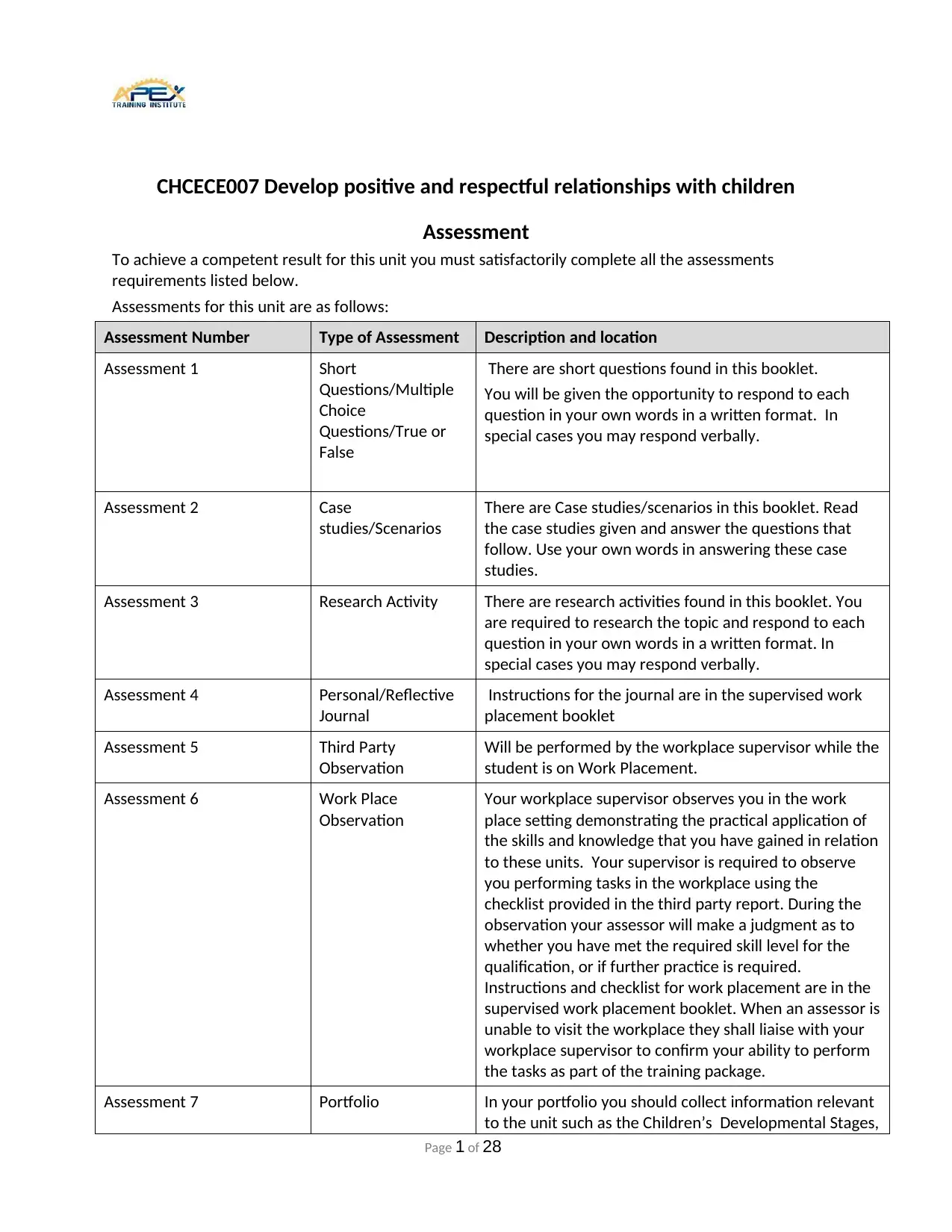
CHCECE007 Develop positive and respectful relationships with children
Assessment
To achieve a competent result for this unit you must satisfactorily complete all the assessments
requirements listed below.
Assessments for this unit are as follows:
Assessment Number Type of Assessment Description and location
Assessment 1 Short
Questions/Multiple
Choice
Questions/True or
False
There are short questions found in this booklet.
You will be given the opportunity to respond to each
question in your own words in a written format. In
special cases you may respond verbally.
Assessment 2 Case
studies/Scenarios
There are Case studies/scenarios in this booklet. Read
the case studies given and answer the questions that
follow. Use your own words in answering these case
studies.
Assessment 3 Research Activity There are research activities found in this booklet. You
are required to research the topic and respond to each
question in your own words in a written format. In
special cases you may respond verbally.
Assessment 4 Personal/Reflective
Journal
Instructions for the journal are in the supervised work
placement booklet
Assessment 5 Third Party
Observation
Will be performed by the workplace supervisor while the
student is on Work Placement.
Assessment 6 Work Place
Observation
Your workplace supervisor observes you in the work
place setting demonstrating the practical application of
the skills and knowledge that you have gained in relation
to these units. Your supervisor is required to observe
you performing tasks in the workplace using the
checklist provided in the third party report. During the
observation your assessor will make a judgment as to
whether you have met the required skill level for the
qualification, or if further practice is required.
Instructions and checklist for work placement are in the
supervised work placement booklet. When an assessor is
unable to visit the workplace they shall liaise with your
workplace supervisor to confirm your ability to perform
the tasks as part of the training package.
Assessment 7 Portfolio In your portfolio you should collect information relevant
to the unit such as the Children’s Developmental Stages,
Page 1 of 28
Assessment
To achieve a competent result for this unit you must satisfactorily complete all the assessments
requirements listed below.
Assessments for this unit are as follows:
Assessment Number Type of Assessment Description and location
Assessment 1 Short
Questions/Multiple
Choice
Questions/True or
False
There are short questions found in this booklet.
You will be given the opportunity to respond to each
question in your own words in a written format. In
special cases you may respond verbally.
Assessment 2 Case
studies/Scenarios
There are Case studies/scenarios in this booklet. Read
the case studies given and answer the questions that
follow. Use your own words in answering these case
studies.
Assessment 3 Research Activity There are research activities found in this booklet. You
are required to research the topic and respond to each
question in your own words in a written format. In
special cases you may respond verbally.
Assessment 4 Personal/Reflective
Journal
Instructions for the journal are in the supervised work
placement booklet
Assessment 5 Third Party
Observation
Will be performed by the workplace supervisor while the
student is on Work Placement.
Assessment 6 Work Place
Observation
Your workplace supervisor observes you in the work
place setting demonstrating the practical application of
the skills and knowledge that you have gained in relation
to these units. Your supervisor is required to observe
you performing tasks in the workplace using the
checklist provided in the third party report. During the
observation your assessor will make a judgment as to
whether you have met the required skill level for the
qualification, or if further practice is required.
Instructions and checklist for work placement are in the
supervised work placement booklet. When an assessor is
unable to visit the workplace they shall liaise with your
workplace supervisor to confirm your ability to perform
the tasks as part of the training package.
Assessment 7 Portfolio In your portfolio you should collect information relevant
to the unit such as the Children’s Developmental Stages,
Page 1 of 28
Paraphrase This Document
Need a fresh take? Get an instant paraphrase of this document with our AI Paraphraser

Playground policies etc.
Page 2 of 28
Page 2 of 28

Instructions to the Student
Please read all the information given to you before you start any assessment task. If you do not
understand some or all of the questions, please ask your trainer/assessor for assistance.
Attempt to answer ALL questions in your own words on the assessment paper provided. The questions
are designed to assess your understanding of the unit as well as your underpinning knowledge.To
satisfactorily complete this assessment task you are required to complete the whole assessment. To do
this you will need to answer all questions correctly and demonstrate you have achieved the required
knowledge to industry standards. This assessment is intended to be fair and flexible. If you feel that we
should change any aspect of this assessment to be fair, equitable or flexible, immediately contact your
assessor who will attempt to make alternative arrangements.
Page 3 of 28
Please read all the information given to you before you start any assessment task. If you do not
understand some or all of the questions, please ask your trainer/assessor for assistance.
Attempt to answer ALL questions in your own words on the assessment paper provided. The questions
are designed to assess your understanding of the unit as well as your underpinning knowledge.To
satisfactorily complete this assessment task you are required to complete the whole assessment. To do
this you will need to answer all questions correctly and demonstrate you have achieved the required
knowledge to industry standards. This assessment is intended to be fair and flexible. If you feel that we
should change any aspect of this assessment to be fair, equitable or flexible, immediately contact your
assessor who will attempt to make alternative arrangements.
Page 3 of 28
⊘ This is a preview!⊘
Do you want full access?
Subscribe today to unlock all pages.

Trusted by 1+ million students worldwide
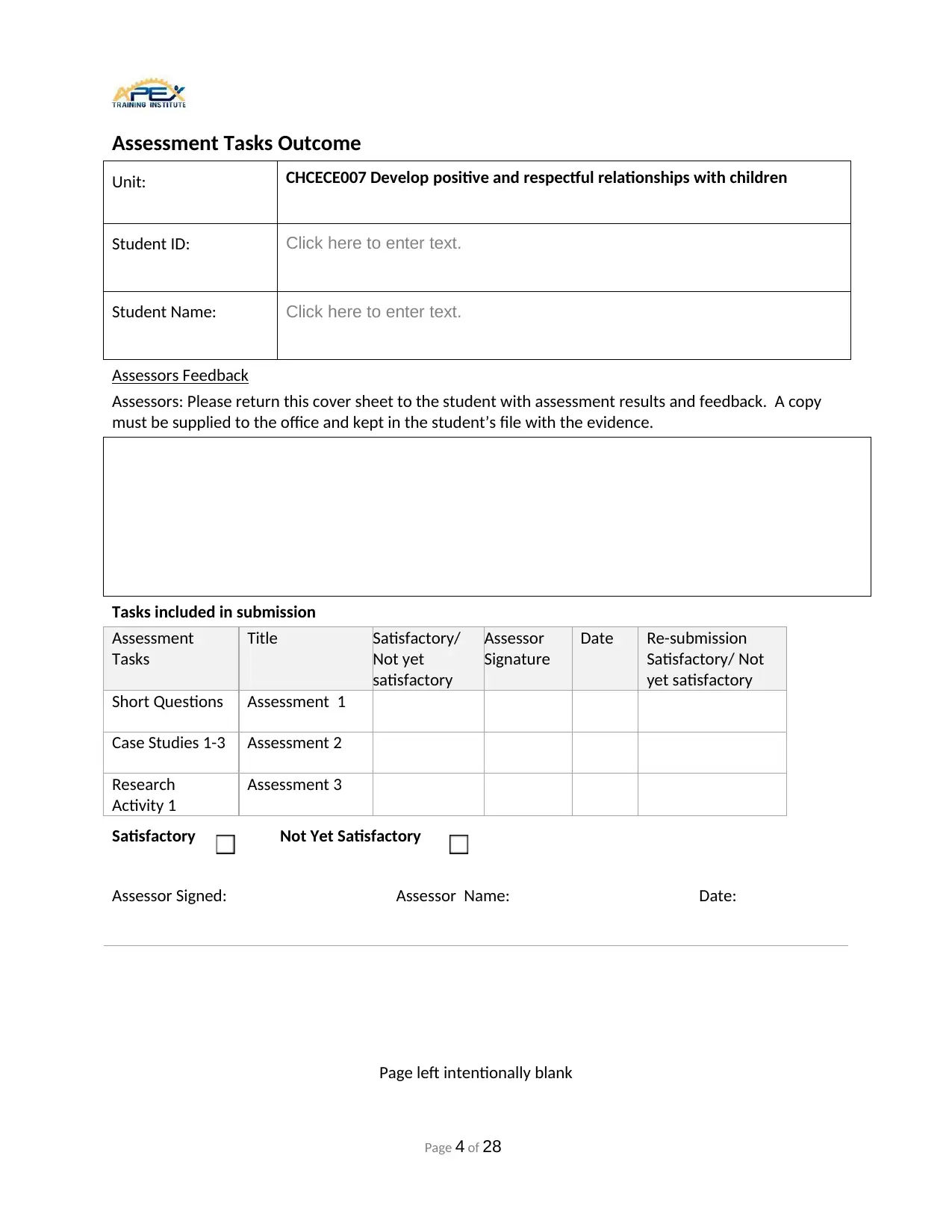
Assessment Tasks Outcome
Unit: CHCECE007 Develop positive and respectful relationships with children
Student ID: Click here to enter text.
Student Name: Click here to enter text.
Assessors Feedback
Assessors: Please return this cover sheet to the student with assessment results and feedback. A copy
must be supplied to the office and kept in the student’s file with the evidence.
Tasks included in submission
Assessment
Tasks
Title Satisfactory/
Not yet
satisfactory
Assessor
Signature
Date Re-submission
Satisfactory/ Not
yet satisfactory
Short Questions Assessment 1
Case Studies 1-3 Assessment 2
Research
Activity 1
Assessment 3
Satisfactory Not Yet Satisfactory
Assessor Signed: Assessor Name: Date:
Page left intentionally blank
Page 4 of 28
Unit: CHCECE007 Develop positive and respectful relationships with children
Student ID: Click here to enter text.
Student Name: Click here to enter text.
Assessors Feedback
Assessors: Please return this cover sheet to the student with assessment results and feedback. A copy
must be supplied to the office and kept in the student’s file with the evidence.
Tasks included in submission
Assessment
Tasks
Title Satisfactory/
Not yet
satisfactory
Assessor
Signature
Date Re-submission
Satisfactory/ Not
yet satisfactory
Short Questions Assessment 1
Case Studies 1-3 Assessment 2
Research
Activity 1
Assessment 3
Satisfactory Not Yet Satisfactory
Assessor Signed: Assessor Name: Date:
Page left intentionally blank
Page 4 of 28
Paraphrase This Document
Need a fresh take? Get an instant paraphrase of this document with our AI Paraphraser

Page 5 of 28
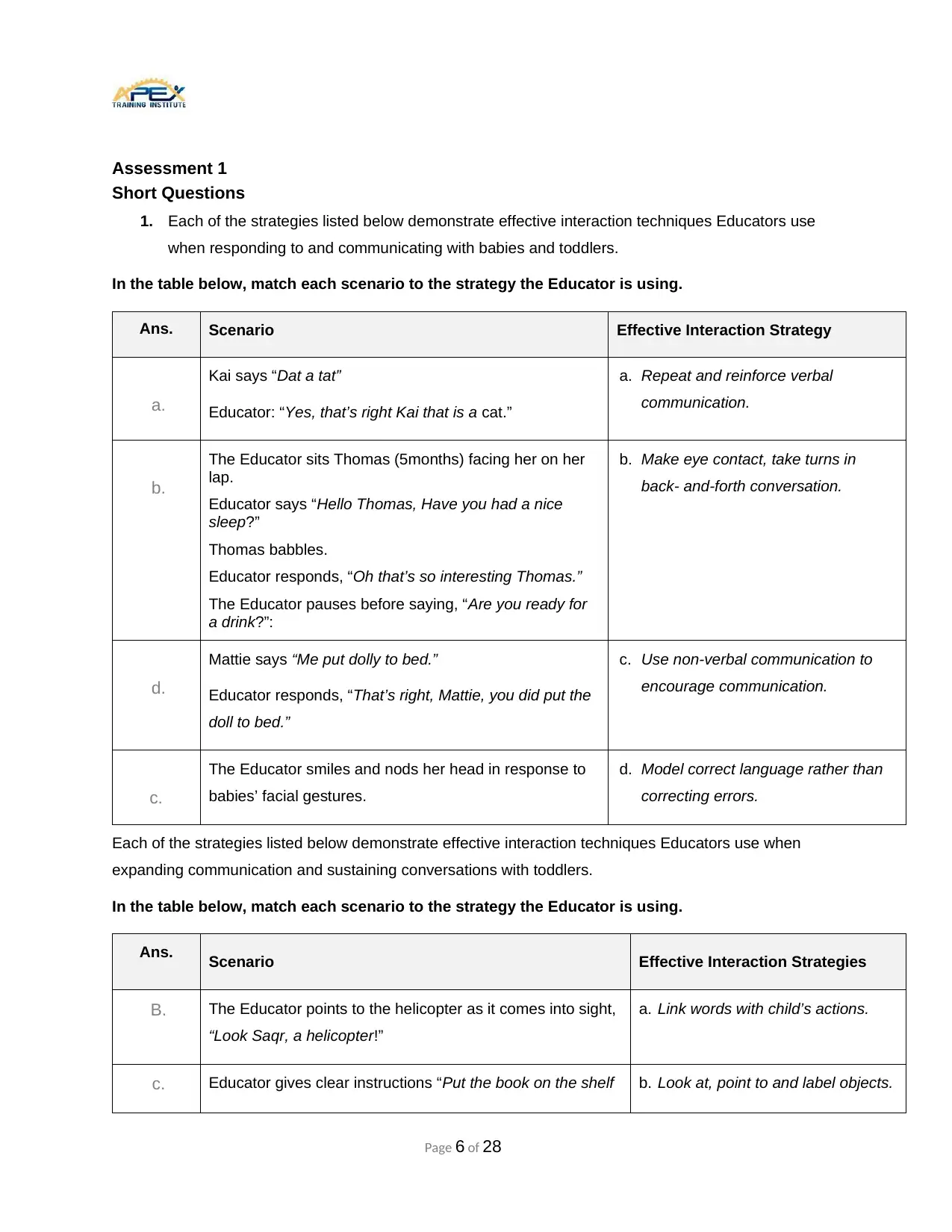
Assessment 1
Short Questions
1. Each of the strategies listed below demonstrate effective interaction techniques Educators use
when responding to and communicating with babies and toddlers.
In the table below, match each scenario to the strategy the Educator is using.
Ans. Scenario Effective Interaction Strategy
a.
Kai says “Dat a tat”
Educator: “Yes, that’s right Kai that is a cat.”
a. Repeat and reinforce verbal
communication.
b.
The Educator sits Thomas (5months) facing her on her
lap.
Educator says “Hello Thomas, Have you had a nice
sleep?”
Thomas babbles.
Educator responds, “Oh that’s so interesting Thomas.”
The Educator pauses before saying, “Are you ready for
a drink?”:
b. Make eye contact, take turns in
back- and-forth conversation.
d.
Mattie says “Me put dolly to bed.”
Educator responds, “That’s right, Mattie, you did put the
doll to bed.”
c. Use non-verbal communication to
encourage communication.
c.
The Educator smiles and nods her head in response to
babies’ facial gestures.
d. Model correct language rather than
correcting errors.
Each of the strategies listed below demonstrate effective interaction techniques Educators use when
expanding communication and sustaining conversations with toddlers.
In the table below, match each scenario to the strategy the Educator is using.
Ans. Scenario Effective Interaction Strategies
B. The Educator points to the helicopter as it comes into sight,
“Look Saqr, a helicopter!”
a. Link words with child’s actions.
c. Educator gives clear instructions “Put the book on the shelf b. Look at, point to and label objects.
Page 6 of 28
Short Questions
1. Each of the strategies listed below demonstrate effective interaction techniques Educators use
when responding to and communicating with babies and toddlers.
In the table below, match each scenario to the strategy the Educator is using.
Ans. Scenario Effective Interaction Strategy
a.
Kai says “Dat a tat”
Educator: “Yes, that’s right Kai that is a cat.”
a. Repeat and reinforce verbal
communication.
b.
The Educator sits Thomas (5months) facing her on her
lap.
Educator says “Hello Thomas, Have you had a nice
sleep?”
Thomas babbles.
Educator responds, “Oh that’s so interesting Thomas.”
The Educator pauses before saying, “Are you ready for
a drink?”:
b. Make eye contact, take turns in
back- and-forth conversation.
d.
Mattie says “Me put dolly to bed.”
Educator responds, “That’s right, Mattie, you did put the
doll to bed.”
c. Use non-verbal communication to
encourage communication.
c.
The Educator smiles and nods her head in response to
babies’ facial gestures.
d. Model correct language rather than
correcting errors.
Each of the strategies listed below demonstrate effective interaction techniques Educators use when
expanding communication and sustaining conversations with toddlers.
In the table below, match each scenario to the strategy the Educator is using.
Ans. Scenario Effective Interaction Strategies
B. The Educator points to the helicopter as it comes into sight,
“Look Saqr, a helicopter!”
a. Link words with child’s actions.
c. Educator gives clear instructions “Put the book on the shelf b. Look at, point to and label objects.
Page 6 of 28
⊘ This is a preview!⊘
Do you want full access?
Subscribe today to unlock all pages.

Trusted by 1+ million students worldwide
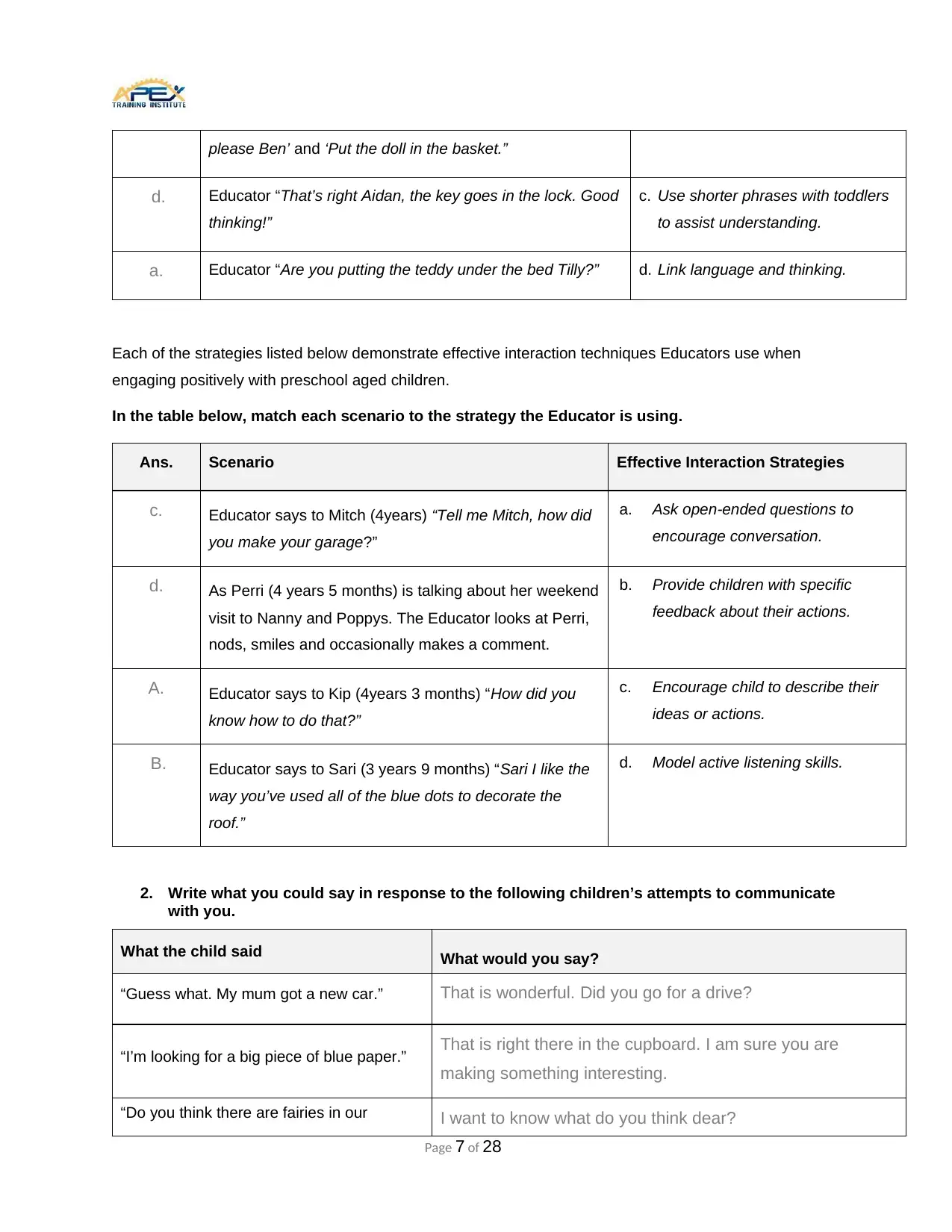
please Ben’ and ‘Put the doll in the basket.”
d. Educator “That’s right Aidan, the key goes in the lock. Good
thinking!”
c. Use shorter phrases with toddlers
to assist understanding.
a. Educator “Are you putting the teddy under the bed Tilly?” d. Link language and thinking.
Each of the strategies listed below demonstrate effective interaction techniques Educators use when
engaging positively with preschool aged children.
In the table below, match each scenario to the strategy the Educator is using.
Ans. Scenario Effective Interaction Strategies
c. Educator says to Mitch (4years) “Tell me Mitch, how did
you make your garage?”
a. Ask open-ended questions to
encourage conversation.
d. As Perri (4 years 5 months) is talking about her weekend
visit to Nanny and Poppys. The Educator looks at Perri,
nods, smiles and occasionally makes a comment.
b. Provide children with specific
feedback about their actions.
A. Educator says to Kip (4years 3 months) “How did you
know how to do that?”
c. Encourage child to describe their
ideas or actions.
B. Educator says to Sari (3 years 9 months) “Sari I like the
way you’ve used all of the blue dots to decorate the
roof.”
d. Model active listening skills.
2. Write what you could say in response to the following children’s attempts to communicate
with you.
What the child said What would you say?
“Guess what. My mum got a new car.” That is wonderful. Did you go for a drive?
“I’m looking for a big piece of blue paper.” That is right there in the cupboard. I am sure you are
making something interesting.
“Do you think there are fairies in our I want to know what do you think dear?
Page 7 of 28
d. Educator “That’s right Aidan, the key goes in the lock. Good
thinking!”
c. Use shorter phrases with toddlers
to assist understanding.
a. Educator “Are you putting the teddy under the bed Tilly?” d. Link language and thinking.
Each of the strategies listed below demonstrate effective interaction techniques Educators use when
engaging positively with preschool aged children.
In the table below, match each scenario to the strategy the Educator is using.
Ans. Scenario Effective Interaction Strategies
c. Educator says to Mitch (4years) “Tell me Mitch, how did
you make your garage?”
a. Ask open-ended questions to
encourage conversation.
d. As Perri (4 years 5 months) is talking about her weekend
visit to Nanny and Poppys. The Educator looks at Perri,
nods, smiles and occasionally makes a comment.
b. Provide children with specific
feedback about their actions.
A. Educator says to Kip (4years 3 months) “How did you
know how to do that?”
c. Encourage child to describe their
ideas or actions.
B. Educator says to Sari (3 years 9 months) “Sari I like the
way you’ve used all of the blue dots to decorate the
roof.”
d. Model active listening skills.
2. Write what you could say in response to the following children’s attempts to communicate
with you.
What the child said What would you say?
“Guess what. My mum got a new car.” That is wonderful. Did you go for a drive?
“I’m looking for a big piece of blue paper.” That is right there in the cupboard. I am sure you are
making something interesting.
“Do you think there are fairies in our I want to know what do you think dear?
Page 7 of 28
Paraphrase This Document
Need a fresh take? Get an instant paraphrase of this document with our AI Paraphraser
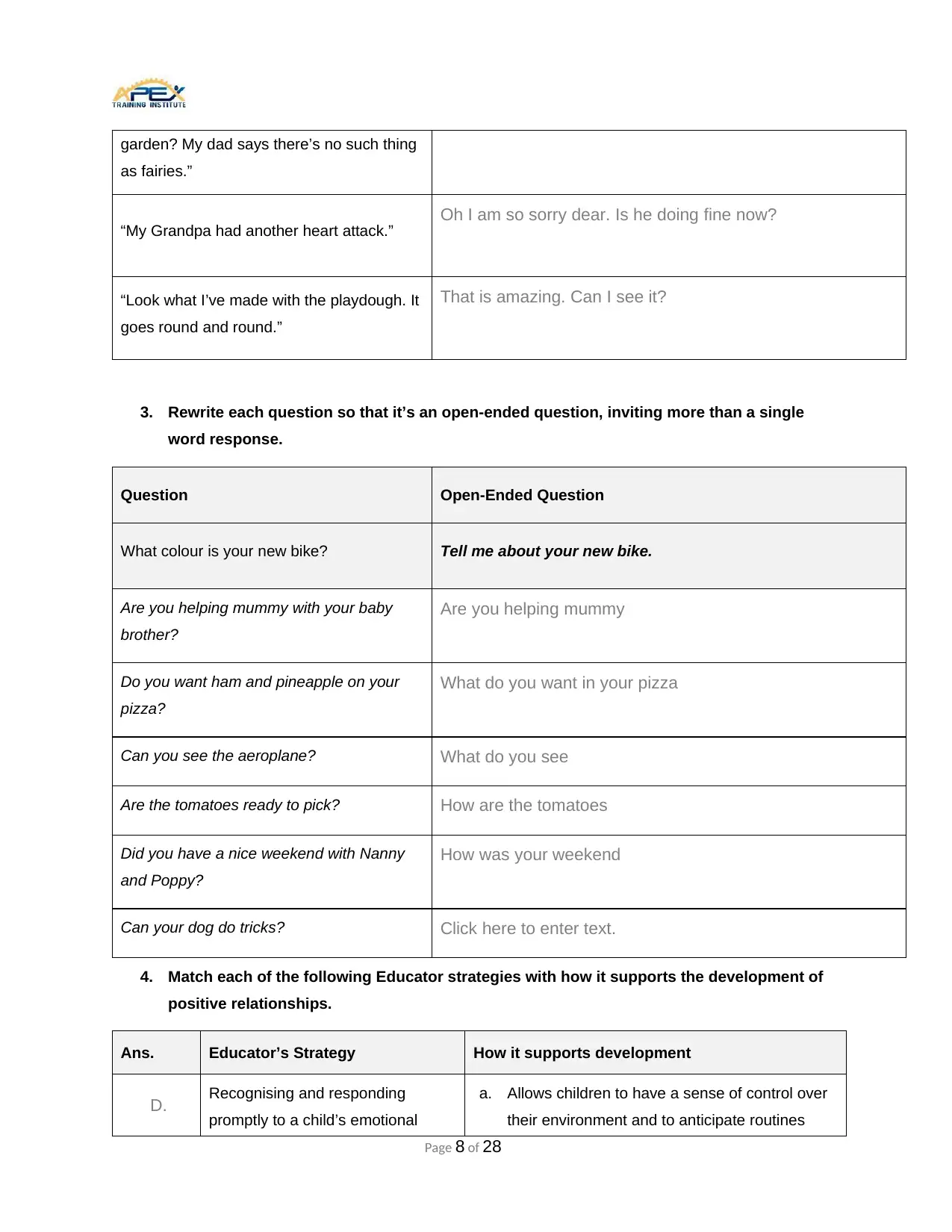
garden? My dad says there’s no such thing
as fairies.”
“My Grandpa had another heart attack.”
Oh I am so sorry dear. Is he doing fine now?
“Look what I’ve made with the playdough. It
goes round and round.”
That is amazing. Can I see it?
3. Rewrite each question so that it’s an open-ended question, inviting more than a single
word response.
Question Open-Ended Question
What colour is your new bike? Tell me about your new bike.
Are you helping mummy with your baby
brother?
Are you helping mummy
Do you want ham and pineapple on your
pizza?
What do you want in your pizza
Can you see the aeroplane? What do you see
Are the tomatoes ready to pick? How are the tomatoes
Did you have a nice weekend with Nanny
and Poppy?
How was your weekend
Can your dog do tricks? Click here to enter text.
4. Match each of the following Educator strategies with how it supports the development of
positive relationships.
Ans. Educator’s Strategy How it supports development
D. Recognising and responding
promptly to a child’s emotional
a. Allows children to have a sense of control over
their environment and to anticipate routines
Page 8 of 28
as fairies.”
“My Grandpa had another heart attack.”
Oh I am so sorry dear. Is he doing fine now?
“Look what I’ve made with the playdough. It
goes round and round.”
That is amazing. Can I see it?
3. Rewrite each question so that it’s an open-ended question, inviting more than a single
word response.
Question Open-Ended Question
What colour is your new bike? Tell me about your new bike.
Are you helping mummy with your baby
brother?
Are you helping mummy
Do you want ham and pineapple on your
pizza?
What do you want in your pizza
Can you see the aeroplane? What do you see
Are the tomatoes ready to pick? How are the tomatoes
Did you have a nice weekend with Nanny
and Poppy?
How was your weekend
Can your dog do tricks? Click here to enter text.
4. Match each of the following Educator strategies with how it supports the development of
positive relationships.
Ans. Educator’s Strategy How it supports development
D. Recognising and responding
promptly to a child’s emotional
a. Allows children to have a sense of control over
their environment and to anticipate routines
Page 8 of 28
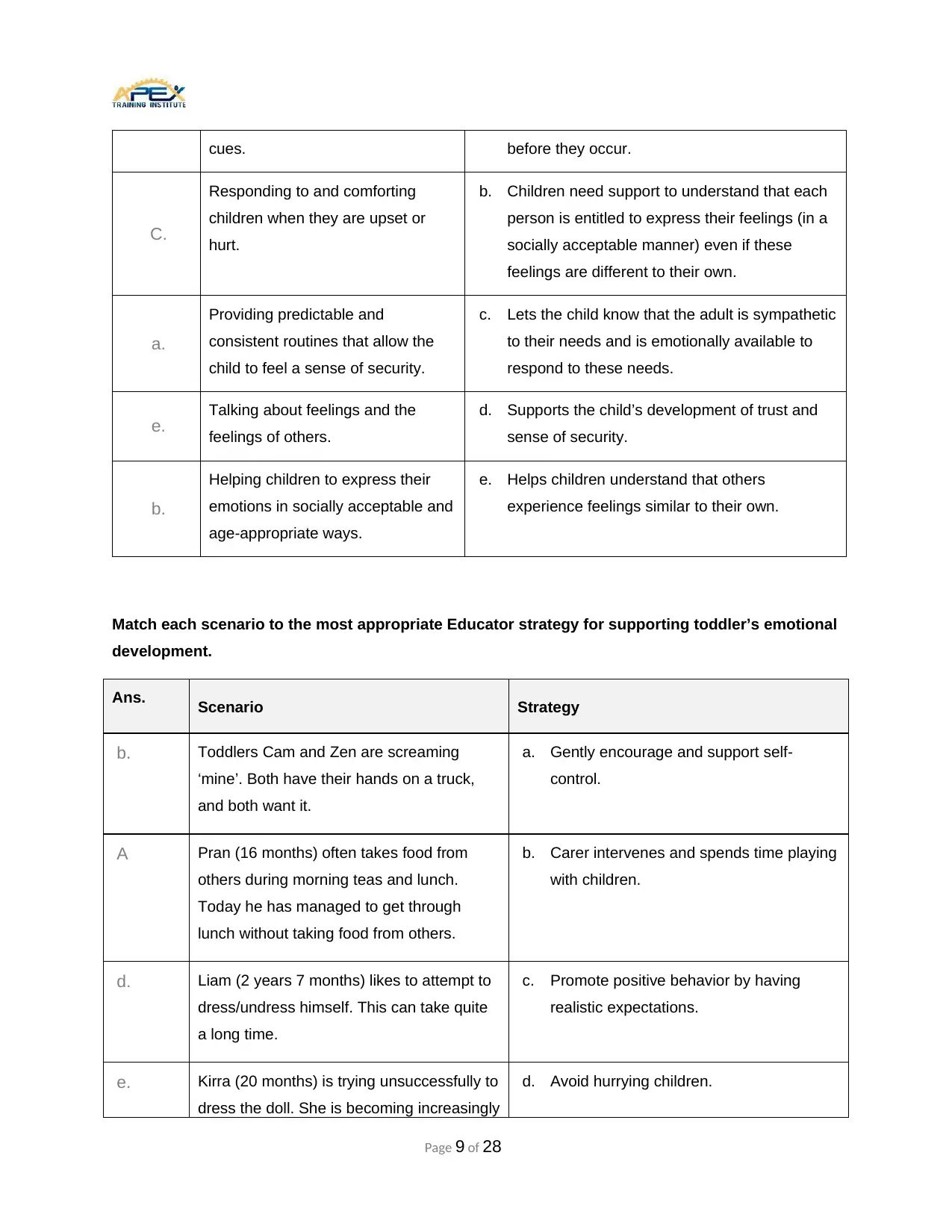
cues. before they occur.
C.
Responding to and comforting
children when they are upset or
hurt.
b. Children need support to understand that each
person is entitled to express their feelings (in a
socially acceptable manner) even if these
feelings are different to their own.
a.
Providing predictable and
consistent routines that allow the
child to feel a sense of security.
c. Lets the child know that the adult is sympathetic
to their needs and is emotionally available to
respond to these needs.
e. Talking about feelings and the
feelings of others.
d. Supports the child’s development of trust and
sense of security.
b.
Helping children to express their
emotions in socially acceptable and
age-appropriate ways.
e. Helps children understand that others
experience feelings similar to their own.
Match each scenario to the most appropriate Educator strategy for supporting toddler’s emotional
development.
Ans. Scenario Strategy
b. Toddlers Cam and Zen are screaming
‘mine’. Both have their hands on a truck,
and both want it.
a. Gently encourage and support self-
control.
A Pran (16 months) often takes food from
others during morning teas and lunch.
Today he has managed to get through
lunch without taking food from others.
b. Carer intervenes and spends time playing
with children.
d. Liam (2 years 7 months) likes to attempt to
dress/undress himself. This can take quite
a long time.
c. Promote positive behavior by having
realistic expectations.
e. Kirra (20 months) is trying unsuccessfully to
dress the doll. She is becoming increasingly
d. Avoid hurrying children.
Page 9 of 28
C.
Responding to and comforting
children when they are upset or
hurt.
b. Children need support to understand that each
person is entitled to express their feelings (in a
socially acceptable manner) even if these
feelings are different to their own.
a.
Providing predictable and
consistent routines that allow the
child to feel a sense of security.
c. Lets the child know that the adult is sympathetic
to their needs and is emotionally available to
respond to these needs.
e. Talking about feelings and the
feelings of others.
d. Supports the child’s development of trust and
sense of security.
b.
Helping children to express their
emotions in socially acceptable and
age-appropriate ways.
e. Helps children understand that others
experience feelings similar to their own.
Match each scenario to the most appropriate Educator strategy for supporting toddler’s emotional
development.
Ans. Scenario Strategy
b. Toddlers Cam and Zen are screaming
‘mine’. Both have their hands on a truck,
and both want it.
a. Gently encourage and support self-
control.
A Pran (16 months) often takes food from
others during morning teas and lunch.
Today he has managed to get through
lunch without taking food from others.
b. Carer intervenes and spends time playing
with children.
d. Liam (2 years 7 months) likes to attempt to
dress/undress himself. This can take quite
a long time.
c. Promote positive behavior by having
realistic expectations.
e. Kirra (20 months) is trying unsuccessfully to
dress the doll. She is becoming increasingly
d. Avoid hurrying children.
Page 9 of 28
⊘ This is a preview!⊘
Do you want full access?
Subscribe today to unlock all pages.

Trusted by 1+ million students worldwide
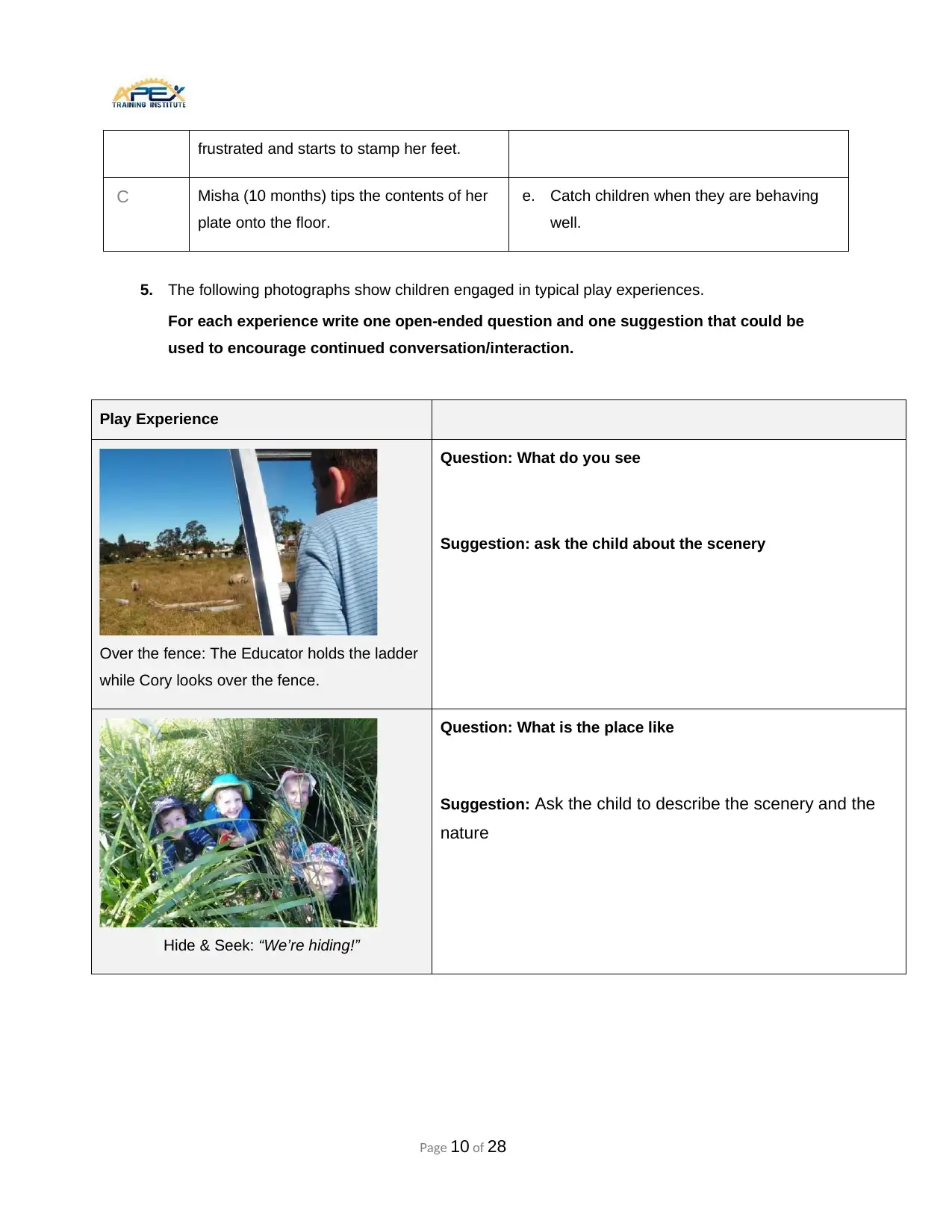
frustrated and starts to stamp her feet.
C Misha (10 months) tips the contents of her
plate onto the floor.
e. Catch children when they are behaving
well.
5. The following photographs show children engaged in typical play experiences.
For each experience write one open-ended question and one suggestion that could be
used to encourage continued conversation/interaction.
Play Experience
Over the fence: The Educator holds the ladder
while Cory looks over the fence.
Question: What do you see
Suggestion: ask the child about the scenery
Hide & Seek: “We’re hiding!”
Question: What is the place like
Suggestion: Ask the child to describe the scenery and the
nature
Page 10 of 28
C Misha (10 months) tips the contents of her
plate onto the floor.
e. Catch children when they are behaving
well.
5. The following photographs show children engaged in typical play experiences.
For each experience write one open-ended question and one suggestion that could be
used to encourage continued conversation/interaction.
Play Experience
Over the fence: The Educator holds the ladder
while Cory looks over the fence.
Question: What do you see
Suggestion: ask the child about the scenery
Hide & Seek: “We’re hiding!”
Question: What is the place like
Suggestion: Ask the child to describe the scenery and the
nature
Page 10 of 28
Paraphrase This Document
Need a fresh take? Get an instant paraphrase of this document with our AI Paraphraser
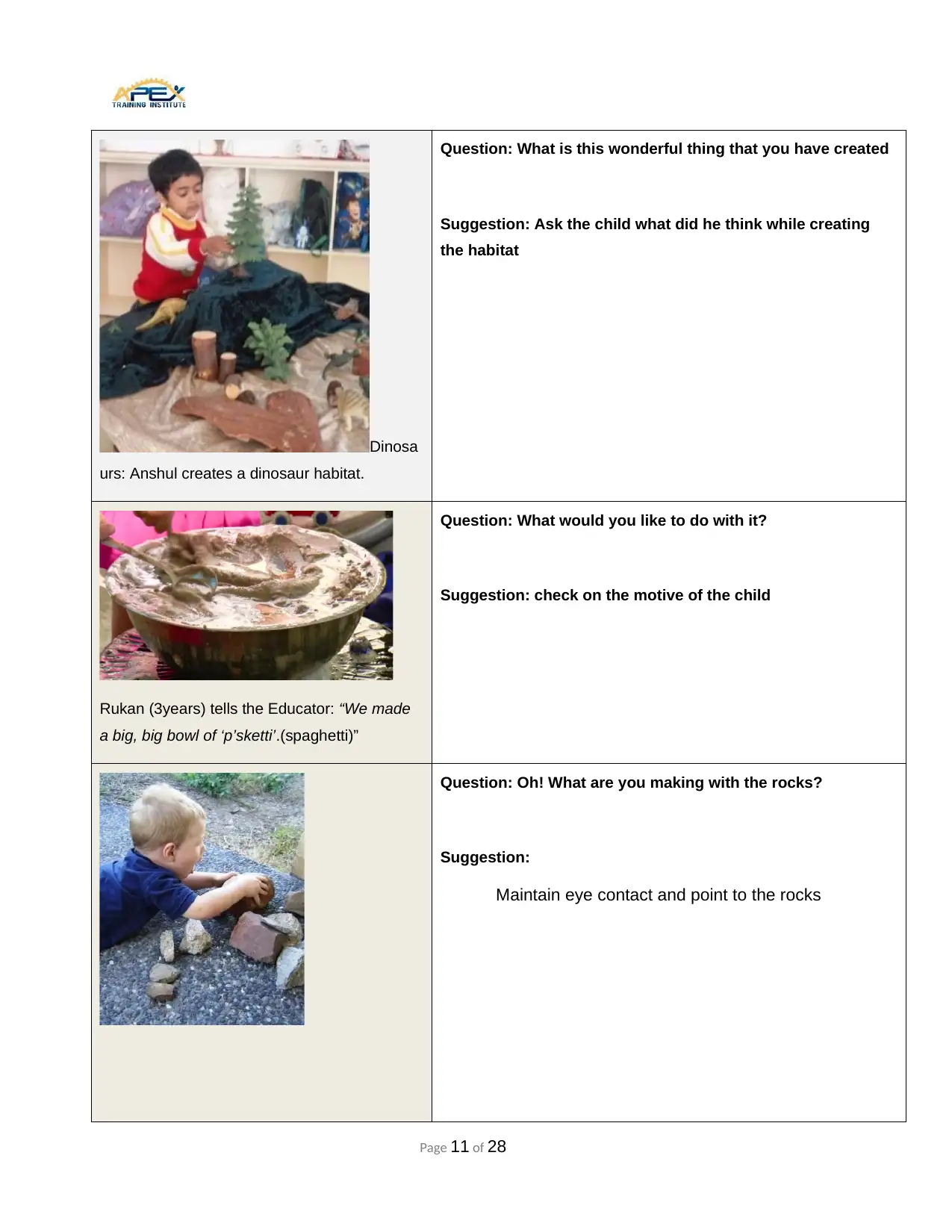
Dinosa
urs: Anshul creates a dinosaur habitat.
Question: What is this wonderful thing that you have created
Suggestion: Ask the child what did he think while creating
the habitat
Rukan (3years) tells the Educator: “We made
a big, big bowl of ‘p’sketti’.(spaghetti)”
Question: What would you like to do with it?
Suggestion: check on the motive of the child
Question: Oh! What are you making with the rocks?
Suggestion:
Maintain eye contact and point to the rocks
Page 11 of 28
urs: Anshul creates a dinosaur habitat.
Question: What is this wonderful thing that you have created
Suggestion: Ask the child what did he think while creating
the habitat
Rukan (3years) tells the Educator: “We made
a big, big bowl of ‘p’sketti’.(spaghetti)”
Question: What would you like to do with it?
Suggestion: check on the motive of the child
Question: Oh! What are you making with the rocks?
Suggestion:
Maintain eye contact and point to the rocks
Page 11 of 28

Drew (18months) piles the rocks together.
6. Look carefully at the examples of Educator’s engaging with children in their play and answer the
related questions.
a. James
The Educator is encouraging James to look closely at the picture of the puzzle before attempting
to complete it. The Educator asks James a series of questions as they explore the picture of the
Eiffel Tower. The Educator refers to colours, shapes, outline, lines, top, bottom and sides.
Page 12 of 28
6. Look carefully at the examples of Educator’s engaging with children in their play and answer the
related questions.
a. James
The Educator is encouraging James to look closely at the picture of the puzzle before attempting
to complete it. The Educator asks James a series of questions as they explore the picture of the
Eiffel Tower. The Educator refers to colours, shapes, outline, lines, top, bottom and sides.
Page 12 of 28
⊘ This is a preview!⊘
Do you want full access?
Subscribe today to unlock all pages.

Trusted by 1+ million students worldwide
1 out of 28
Related Documents
Your All-in-One AI-Powered Toolkit for Academic Success.
+13062052269
info@desklib.com
Available 24*7 on WhatsApp / Email
![[object Object]](/_next/static/media/star-bottom.7253800d.svg)
Unlock your academic potential
Copyright © 2020–2025 A2Z Services. All Rights Reserved. Developed and managed by ZUCOL.





